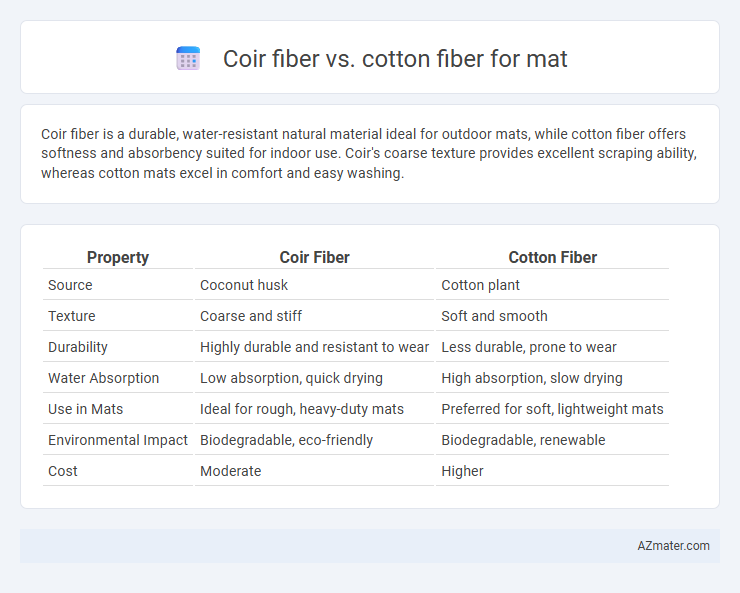Coir fiber is a durable, water-resistant natural material ideal for outdoor mats, while cotton fiber offers softness and absorbency suited for indoor use. Coir's coarse texture provides excellent scraping ability, whereas cotton mats excel in comfort and easy washing.
Table of Comparison
| Property | Coir Fiber | Cotton Fiber |
|---|---|---|
| Source | Coconut husk | Cotton plant |
| Texture | Coarse and stiff | Soft and smooth |
| Durability | Highly durable and resistant to wear | Less durable, prone to wear |
| Water Absorption | Low absorption, quick drying | High absorption, slow drying |
| Use in Mats | Ideal for rough, heavy-duty mats | Preferred for soft, lightweight mats |
| Environmental Impact | Biodegradable, eco-friendly | Biodegradable, renewable |
| Cost | Moderate | Higher |
Introduction to Coir Fiber and Cotton Fiber
Coir fiber, derived from the outer husk of coconut shells, is a natural, coarse, and durable material widely used in mats for its water resistance and resilience. Cotton fiber, obtained from the cotton plant's seed hairs, is soft, absorbent, and breathable, offering comfort and flexibility in mat applications. Both fibers serve distinct purposes in mat manufacturing, with coir favored for heavy-duty use and cotton preferred for softer, indoor environments.
Source and Extraction Processes
Coir fiber is derived from the outer husk of coconut shells through retting and mechanical decortication, making it coarse, durable, and naturally resistant to moisture. Cotton fiber, extracted from the seed hairs of the cotton plant via ginning and combing, provides a soft, breathable, and flexible texture ideal for mats. The extraction of coir involves water soaking and fiber separation techniques, while cotton extraction centers on seed removal and fiber cleaning processes.
Physical Properties Comparison
Coir fiber exhibits higher tensile strength and greater resistance to moisture compared to cotton fiber, making it more durable for mat applications. While coir fibers are coarse and stiff, providing excellent impact absorption and natural water repellency, cotton fibers are softer and more flexible but tend to absorb water and wear out faster. The denser structure of coir contributes to its resilience under heavy usage, whereas cotton offers increased comfort and breathability but lacks long-term robustness.
Environmental Impact and Sustainability
Coir fiber, derived from coconut husks, is highly sustainable due to its biodegradability, renewable sourcing, and minimal water usage compared to cotton fiber, which requires extensive irrigation and pesticides. The environmental impact of cotton mats includes higher carbon emissions and soil depletion, whereas coir mats contribute to waste reduction by utilizing agricultural byproducts. Choosing coir fiber mats supports eco-friendly production practices and promotes circular economy principles in the textile industry.
Comfort and Texture Differences
Coir fiber mats offer a coarse, rough texture that provides firm support and excellent durability, making them suitable for high-traffic areas. Cotton fiber mats, in contrast, are soft and plush, delivering superior comfort and a gentle touch ideal for indoor settings where cushioning is prioritized. The natural breathability of cotton enhances comfort by allowing air circulation, whereas coir's dense structure limits airflow but excels in moisture resistance.
Durability and Lifespan
Coir fiber surpasses cotton fiber in durability due to its coarse, natural resilience and high resistance to wear and moisture, making it ideal for mats exposed to heavy foot traffic or outdoor conditions. Cotton fiber mats, while softer and more comfortable, tend to have a shorter lifespan because they absorb moisture easily, leading to faster degradation and potential mold growth. Choosing coir mats ensures a longer-lasting product resistant to environmental stress, whereas cotton mats require more frequent replacement in similar usage scenarios.
Maintenance and Cleaning Requirements
Coir fiber mats require minimal maintenance due to their natural resistance to dirt and moisture, needing only regular shaking or vacuuming to remove debris. Cotton fiber mats, while softer, often demand more frequent washing to prevent mold and mildew buildup caused by their higher absorbency. Coir mats offer greater durability for outdoor use, whereas cotton mats excel indoors but require careful drying after cleaning to maintain their integrity.
Cost and Market Availability
Coir fiber mats are generally more cost-effective due to the abundance of coconut husk waste in tropical regions, making them widely available and affordable in markets. Cotton fiber mats tend to be pricier because of higher cultivation costs and limited supply constrained by seasonal harvesting. Market availability for coir mats significantly outpaces cotton mats, especially in areas near coconut-producing countries, offering a budget-friendly and sustainable option.
Common Applications in Mat Production
Coir fiber, derived from coconut husks, offers high durability and water resistance, making it ideal for outdoor mats and heavy-traffic areas. Cotton fiber, known for its softness and absorbency, is commonly used in indoor mats, providing comfort and aesthetic appeal. Both fibers serve distinct purposes, with coir favored for rugged utility mats and cotton preferred in decorative or indoor settings.
Conclusion: Choosing the Right Fiber for Mats
Coir fiber offers superior durability and natural water resistance, making it ideal for outdoor or high-traffic mats, while cotton fiber provides a softer texture and better absorbency suited for indoor use. The decision hinges on balancing toughness against comfort and moisture management based on the mat's intended environment. Selecting coir ensures longevity and resilience, whereas cotton prioritizes softness and ease of cleaning for indoor spaces.

Infographic: Coir fiber vs Cotton fiber for Mat
 azmater.com
azmater.com